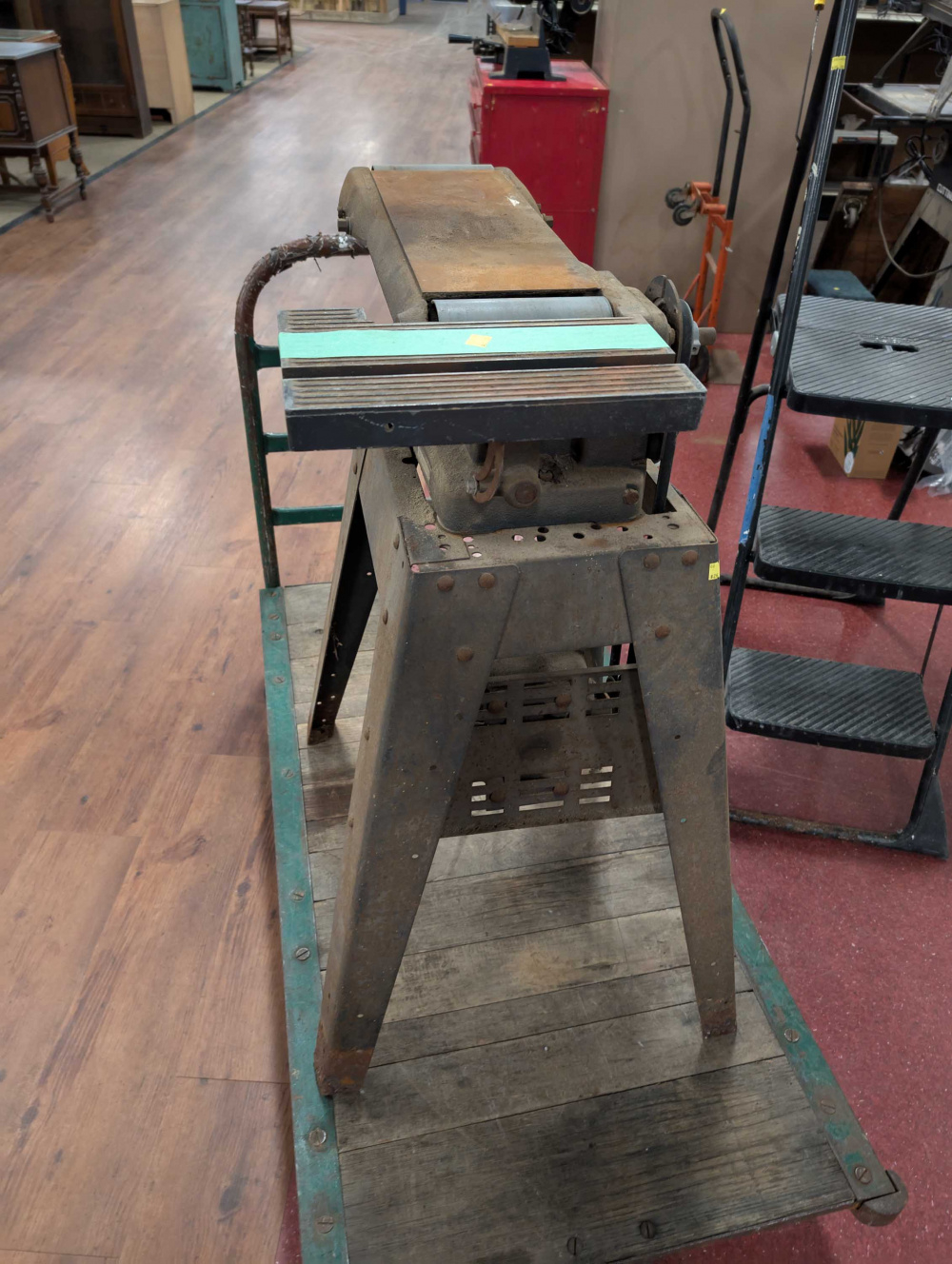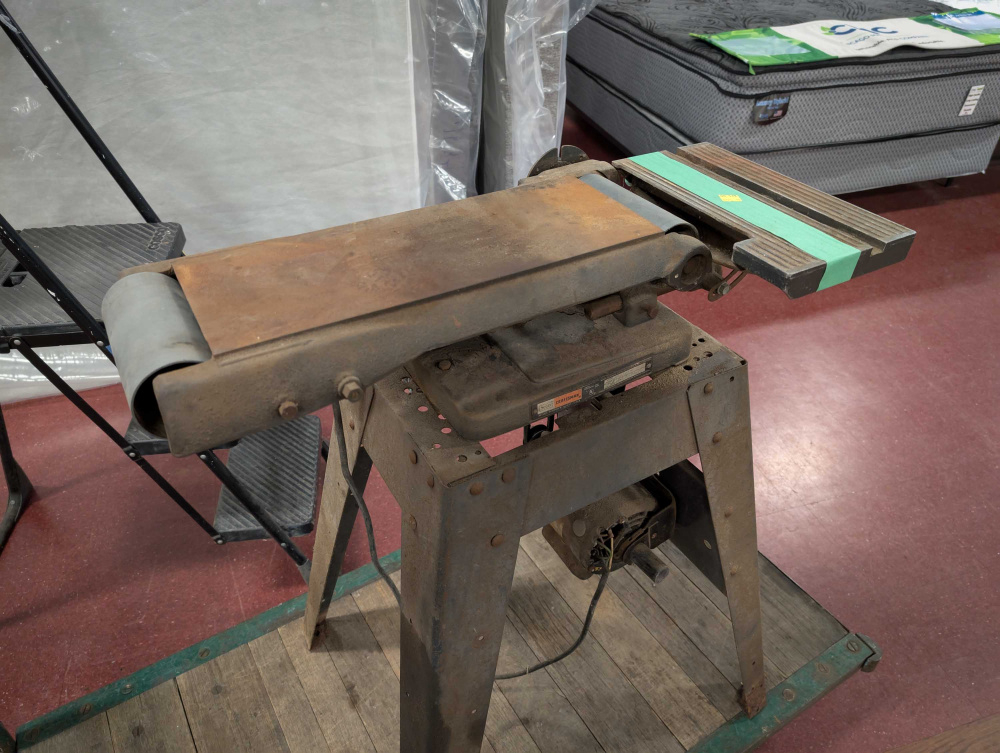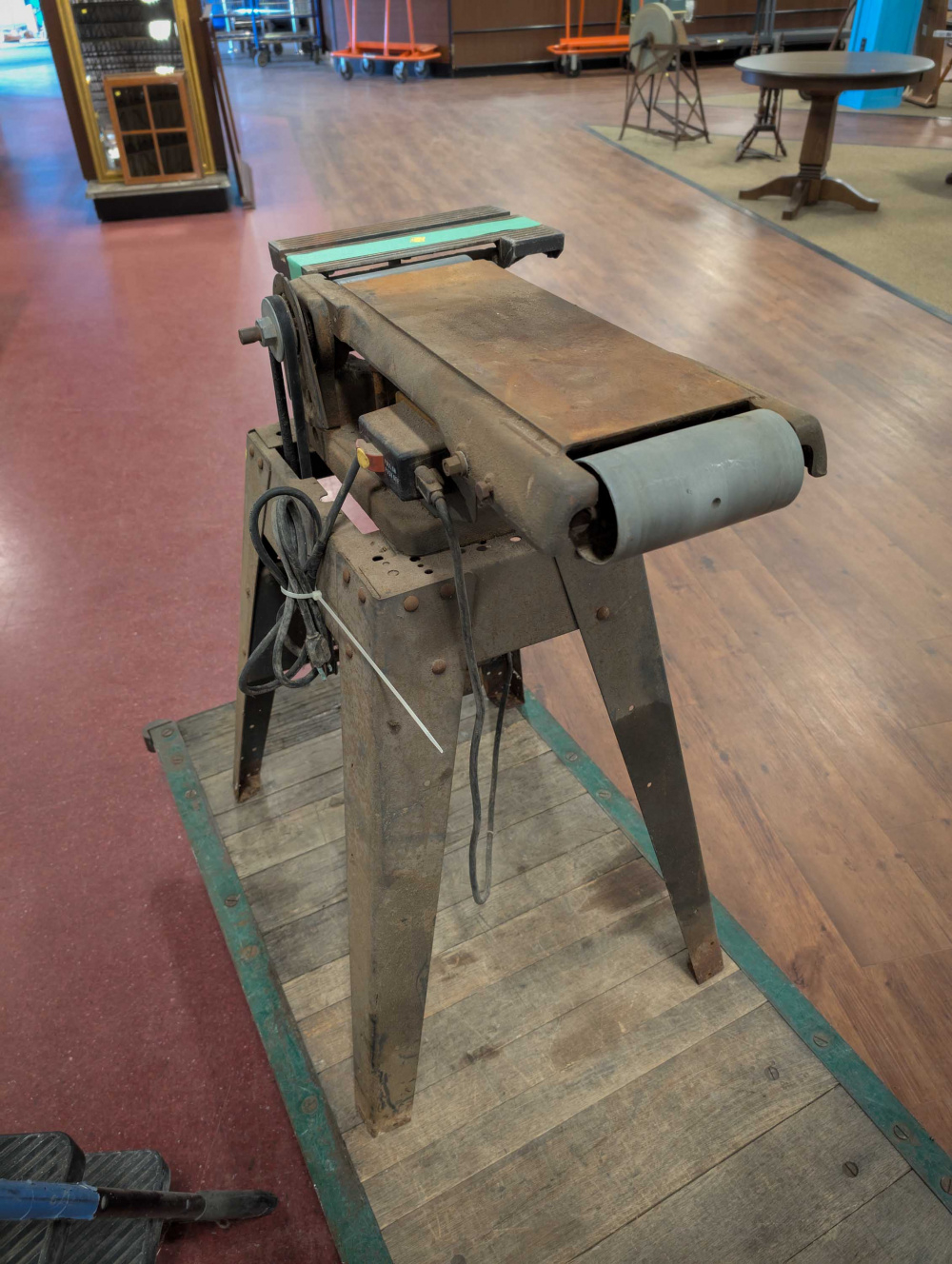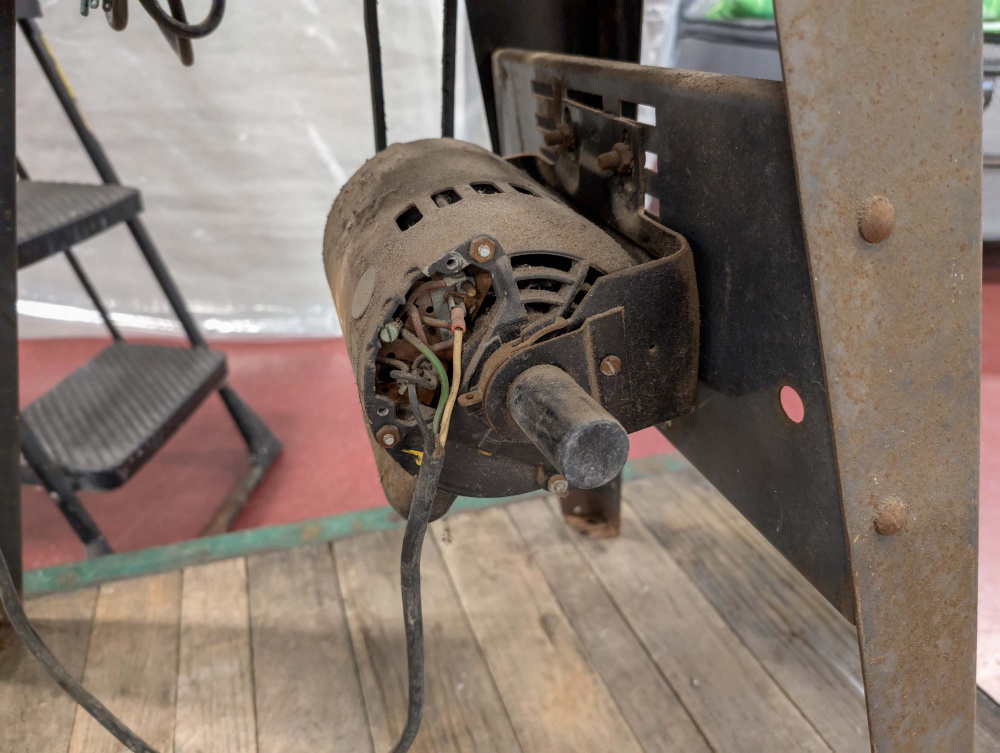Site Links
Howdy, Stranger!
It looks like you're new here. If you want to get involved, click one of these buttons!
Quick Links
Categories
In this Discussion
Who's Online (0)
Vintage Belt & Disc Sander Restoration
Found this gem last Saturday at my local restore. Dirt cheap: $25 US. It has a solid, super heavy cast iron base and belt table. It took two people to load it into my car.
This unit sold for $319 in 1981, which is about $1176 in today's CPI inflated dollars. Here is a picture of the sander, when new, found on page 13 of Sear's 81/82 tool catalog:
https://archive.org/details/sears-tools-catalog-1981-82/page/13/mode/1up
The front bearings were shot and the motor looked a little crusty. But since I have never had a nice, heavy duty sander like this, I could not resist. Little did I know what I was getting myself into. More to come.










Comments
Great find/buy Bill. There are some good videos on youtube showing how to best remove that rust. I bought my tablesaw off craigslist which had sat in a leaky shed for 30+ years. Its cast iron top was way worse than that. A little elbow grease and now it's served me well for the past 12+ years.
Thanks, Craig. I watched several videos. Most seemed to first buff the rust off with WD-40 and very fine 600 or 400 grit wet type sandpaper. Then cleaned the rusty slurry off with paper towels. Repeated this process 3 or 4 times until all the rust was gone,. Most then applied wax and buffed it out to make the table saw slippery. Think I'll skip the wax part, because any wax on the surface of the sander will probably grind off in the first 10 seconds of operation.
One guy took his table saw completely apart, built a small DIY swimming pool out of an old cardboard box, and then dumped all the cast iron sections into a solution of vinegar and water. Don't think I want to do that.
A tip for cleaning cast iron to help prevent future rusting.
After rust removal (wd40 is great w/wet dry paper). really clean it with lots mineral spirits and lots of paper towel. Keep at it until the towels come away clean.
After that apply some paste wax. Buff out well.
I should add that heating the first 1-3 applications of wax helps tremendously. Use a hair drier to just liquify the wax and wipe. You will probably see gray on the paper towel. Repeat until the paper comes away clean and it will last for years.
I have that exact sander sans stand. It's nice!
You sure seem to find some great stuff, Bill. I haven't been in our Restore in years, but they never had any electronics or decent tools.
I bet that motor could be serviced easy enough and or find a replacement.
Probably just a good douche with some air and should be fine...maybe
KROIL is fabulous for rust removal and smells nice too.
Kroil is great lube for your pocket knife as well.
Bill, I too have that same sander. I would highly recommend you get the biggest motor you can find. Tim Taylor the crap out of that thing.
Thanks guys! Lots of great tips! Keep them coming. I gave the cast iron surface some fine grit wet sanding/cleaning applications using Super Tech penetrating lubricant, mineral spirits, and paper towels. I think this Super Tech stuff is the same as WD-40, except it is sold at about half the price by Walmart. Seemed to work pretty good, removed most of the rust. The grinding and swirling marks in the photos did not come from my sanding/cleaning work. These marks were already there, underneath the rust, caused by years and years of sanding belt friction. Looks like I need to perform a few more sanding/cleaning operations to get it all.
It's funny. I initially began stopping at re-stores in my area a few years ago looking for wood. But I could never find anything decent. But as I was walking around, I kept stumbling onto cool electronics and tools. Maybe it is just dumb luck on my part, I don't know. But one thing I do know is that when I stumble onto a really good find, if I don't buy it immediately, it is usually gone when I stop back 1 week later.
Ya, I blew the dust out with my air hose. Plugged it in without the belt attached and it spins up good with lots of torque. Sounds like it could use some lubrication on the main bearings.
I did a google search on KROIL. That must be the "premo" stuff for this type of work. It seems to be fairly expensive compared to WD-40 or Super Tech penetrating lubricant.
The motor has capacitor start, probably a polyproplyene type. 3/4 HP. Might be a little wimpy for grinding out huge baffle diffraction roundovers.
Start capacitors like on your motor, are almost always electrolytic. Run caps are poly.
I ran my sander with a split phase blower motor around 1/3 hp for years. No caps on those. I doubt your motor will complain.
The semi circular grooves are from initial machining. These things were pretty roughly ground from the factory.
The straighter lines are from use, as is the more polished portions.
Don't skip the mineral spirits and wax. The wax isn't so much for lubrication in this case, but for rust prevention. Cast iron is very porous metal, the wax fills the pores helps to seal out moisture.
Thanks, Bob. Excellent tips. I'll be sure to do both the mineral spirits and wax. I was going to skip the wax because I figured it would just be scraped off by the sanding belt. But as you indicate, that is not true. I'll be keeping this thing in the basement, so I need all the rust prevention I can get. I also keep a dehumidier cycling on and off to keep my basement dry, but the humidity level is always about 10% higher than upstairs.
I was going to skip checking the motor capacitor because I thought, in error, that they were probably poly's, which basically last forever. I'll be sure to pop the cover and test the electrolytic for leakage and replace as necessary. Thanks again for the excellent tips!
Jantzen Superior
Glad you found it helpful!
Besides cleaning up the gasket surface on some crusty old exhaust manifolds... What would you guys use this for?
Maybe the intake a couple ex girlfriends
Future plans include custom baffle diffraction profiles in and around the tweeter flange area. Maybe try creating some unique and interesting shapes by sanding to custom guideline layouts. Sure wish I had this machine when I built the Radiusaurus speakers. Or the Doctor Diffraction speakers.
I will need roughly 240uF (216-259MFD) and a high voltage rating. So, multiples of the Jantzen Superior 22uF 1200V units will be my only choice. I'll need to parallel up 11 of them to get 240. Total cost: $1292.72. The only problem is that they are currently out of stock at Parts Express!
https://www.parts-express.com/Jantzen-0590-22uF-1200V-Z-Superior-Capacitor-027-499?quantity=1
I checked the Mallory electrolytic motor start capacitor on my multimeter and it measured in the range of 219 to 255uF, depending on how much residual voltage charge was still in the cap. I also tested it for leakage on my Eico 950B capacitance bridge. With 125vdc applied, the eye tube slowly opens to about half way and then stays there. I cannot get the eye tube to open completely unless I drop the voltage to about 75vdc. Compared to other electrolytics of the same capacitance and voltage, this indicates that the Mallory cap is slightly leaky, but probably still OK. Drop in replacements for these caps are available from several sources. So I might consider replacing it. Or I could just wait until it fails. If it fails, it would probably just open up and then the motor would not start.
I have some 100uF/450V caps if you need.
Start caps are usually pretty cheap, I would replace it just because.
Thanks for the offer, Eric. I'm not sure, but I think these caps are nonpolarized (NPE) and what you have is probably polarized. I'd didn't see any plus or minus marks on the cap, so that indicates that it is probably nonpolar. Also, 100uF might not be a high enough value to start the motor or fit into the existing bump out case. I'd like to replace it with one that is an exact fit. Think I'll just add one of the below Cornell-Dubilier units to my next mouser order. They will drop right in.
https://www.mouser.com/ProductDetail/Cornell-Dubilier-CDE/PSU21615?qs=9I6i58cghuvXxhongk1vJg==
Here is why they were selling this sander dirt cheap for $25. The bearings were almost brand new and had been recently replaced. But the main shaft was badly worn due to inner bearing race slippage. The main shaft is supposed to be 0.625" in diameter, but was worn down to 0.500" diameter beneath the pulley side bearing and worn down to about 0.590" diameter on the opposite side. I'm guessing that the previous owner had taken this apart recently and replaced both bearings but could not replace the shaft because it was (and is) NLA. Since both bearings were still good, I inserted two bushings on the worn shaft areas, turned them down to 0.635" and then press fit the two almost new bearings back into position, locking both bearings in place with the original retaining rings. Put it all back together and it spins great with no inner bearing race slippage or runout. I had to press fit the bearings into position with a long 1" diameter pipe and a hammer, so they are never coming loose. I will have to use my pulley puller to pull them out if I should ever need to do this again.
That ol girl must've had some mileage on it!
Nice repair work! That was some serious wear.
Nice machine work too . . .